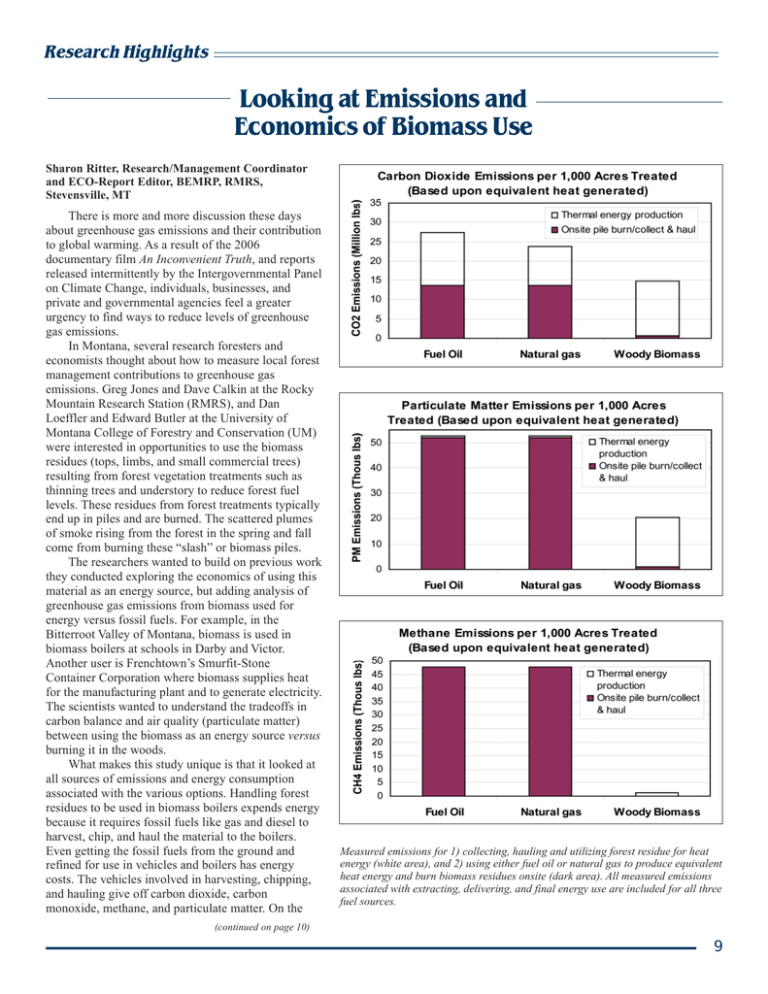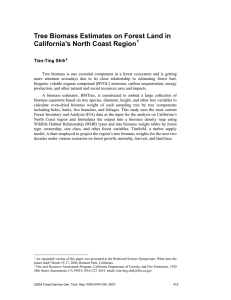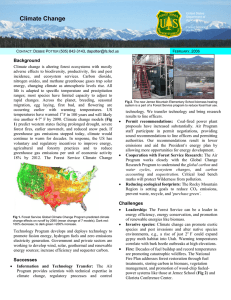Looking at Emissions and Economics of Biomass Use Research Highlights
advertisement

Research Highlights Looking at Emissions and Economics of Biomass Use Sharon Ritter, Research/Management Coordinator and ECO-Report Editor, BEMRP, RMRS, Stevensville, MT There is more and more discussion these days about greenhouse gas emissions and their contribution to global warming. As a result of the 2006 documentary film An Inconvenient Truth, and reports released intermittently by the Intergovernmental Panel on Climate Change, individuals, businesses, and private and governmental agencies feel a greater urgency to find ways to reduce levels of greenhouse gas emissions. In Montana, several research foresters and economists thought about how to measure local forest management contributions to greenhouse gas emissions. Greg Jones and Dave Calkin at the Rocky Mountain Research Station (RMRS), and Dan Loeffler and Edward Butler at the University of Montana College of Forestry and Conservation (UM) were interested in opportunities to use the biomass residues (tops, limbs, and small commercial trees) resulting from forest vegetation treatments such as thinning trees and understory to reduce forest fuel levels. These residues from forest treatments typically end up in piles and are burned. The scattered plumes of smoke rising from the forest in the spring and fall come from burning these “slash” or biomass piles. The researchers wanted to build on previous work they conducted exploring the economics of using this material as an energy source, but adding analysis of greenhouse gas emissions from biomass used for energy versus fossil fuels. For example, in the Bitterroot Valley of Montana, biomass is used in biomass boilers at schools in Darby and Victor. Another user is Frenchtown’s Smurfit-Stone Container Corporation where biomass supplies heat for the manufacturing plant and to generate electricity. The scientists wanted to understand the tradeoffs in carbon balance and air quality (particulate matter) between using the biomass as an energy source versus burning it in the woods. What makes this study unique is that it looked at all sources of emissions and energy consumption associated with the various options. Handling forest residues to be used in biomass boilers expends energy because it requires fossil fuels like gas and diesel to harvest, chip, and haul the material to the boilers. Even getting the fossil fuels from the ground and refined for use in vehicles and boilers has energy costs. The vehicles involved in harvesting, chipping, and hauling give off carbon dioxide, carbon monoxide, methane, and particulate matter. On the Measured emissions for 1) collecting, hauling and utilizing forest residue for heat energy (white area), and 2) using either fuel oil or natural gas to produce equivalent heat energy and burn biomass residues onsite (dark area). All measured emissions associated with extracting, delivering, and final energy use are included for all three fuel sources. (continued on page 10) 9 Looking at Emissions . . ( from page 9) fossil fuels for energy and burning the biomass at the harvest site (see graphs). Particulate matter less than 10 microns in size (PM-10) decreases by even more—75 percent. Methane, a short-lived but very harmful component of greenhouse gases, can be reduced by 90% by burning the biomass in boilers rather than outside. Another advantage of burning biomass for energy is that there is a net increase in the amount of greenhouse gases that remain sequestered under ground from unused fossil fuels, rather than released into the atmosphere. Next the researchers want to look at other economic aspects including the possibility that groups using biomass boilers could sell carbon offsets. Carbon offsets counteract or offset greenhouse gases that would have been emitted into the atmosphere. For example, the Townsend school and Montana Fuels for Schools Program have sold carbon offsets through the Climate Trust to offset carbon produced at the Basin Electric Power Plant in Butte. What was once considered waste has now taken on a value, both economically and environmentally. The researchers’ results show that by taking into account all sources of emissions, the decrease in emissions are even larger than originally thought. This biomass boiler provides heat to the school in Darby, Montana. Emissions are very low from this type of boiler. (Photo by U.S. Forest Service) other hand, burning biomass in place also releases these pollutants. So the question came down to this: What’s the best thing to do from an economic and emissions perspective—use fossil fuels such as natural gas or heating oil to heat a building and burn the biomass on site, or chip and haul the biomass to a nearby boiler and use it for energy instead of fossil fuels? What the researchers found was that from an economics standpoint it is cost-effective to haul this material to a utilization site such as Darby school’s boiler or even the more distant Frenchtown boiler, as long as the haul distance was a maximum of 40 to 50 miles (given the current market and fuel prices). Based on Environmental Protection Agency emission factors, they also found that using the biomass for the equivalent amount of thermal energy would release approximately half of the carbon dioxide compared to using Tree tops, limbs, and small trees (biomass) left over from a thinning project on the Bitterroot National Forest. Originally scheduled to be burned, it instead went to Darby for use in the boiler. (Photo by U.S. Forest Service) Meet BEMRP’s Executive Committee BEMRP is a multi-disciplinary partnership that brings together these scientists from the U.S. Forest Service Rocky Mountain Research Station and the University of Montana, together with managers from the Bitterroot National Forest and Northern Region. Greg Jones—RMRS Social, Economics, and Decision Science Program Dave Calkin— RMRS Social, Economics, and Decision Science Program Mick Harrington— RMRS Fire, Fuels, and Smoke Science Program Ward McCaughey— RMRS Forest and Woodland Ecosystems Science Program Alan Watson—Aldo Leopold Wilderness Research Institute Dean Pearson—RMRS Wildlife and Terrestrial Habitats Science Program Jim Burchfield—The University of Montana College of Forestry and Conservation Sue Heald—Bitterroot National Forest Kerry McMenus—Northern Region Office Chuck Oliver—Bitterroot National Forest Dan Ritter—Bitterroot National Forest 10




